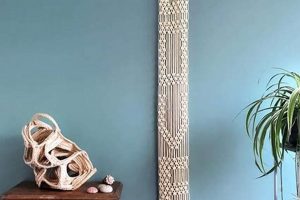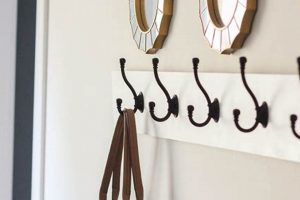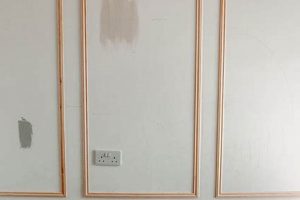The practice of affixing decorative trim to interior vertical surfaces represents a popular method for enhancing aesthetic appeal. This process, undertaken by individuals rather than professional contractors, allows for customization and cost savings in home improvement projects. For example, an individual might install chair rail or picture frame molding to add architectural interest to a room.
Implementing such embellishments can significantly increase a property’s perceived value and visual interest. Historically, this form of ornamentation provided a means to protect walls from damage and conceal imperfections. Furthermore, it offers an opportunity to express personal style and complement existing dcor through a wide range of designs, materials, and finishes.
The following sections will delve into the various types of trim available, the tools and materials required for successful installation, and detailed instructions for executing common projects. Considerations regarding design planning, surface preparation, and finishing techniques will also be addressed.
Essential Installation Guidance
Achieving professional-quality results requires careful planning and execution. Adherence to the following recommendations will improve the overall outcome and longevity of the installation.
Tip 1: Precise Measurement is Paramount. Prior to any cutting, accurate measurements of wall lengths and angles are essential. Double-check all figures to minimize errors and material waste. Create a detailed sketch of the room with all dimensions noted.
Tip 2: Select Appropriate Materials. Consider the environmental conditions and intended aesthetic when choosing trim. Options include wood, medium-density fiberboard (MDF), and polyurethane. MDF is generally more cost-effective but may not be suitable for high-moisture environments.
Tip 3: Invest in Quality Tools. A miter saw is crucial for accurate angle cuts. Other necessary tools include a measuring tape, level, stud finder, nail gun (or hammer and nails), caulk gun, and sandpaper. The quality of these tools directly impacts the final result.
Tip 4: Proper Surface Preparation is Key. Walls should be clean, dry, and free from any loose paint or debris. Fill any holes or imperfections with spackle and sand smooth prior to installation. Priming the wall and the trim ensures proper paint adhesion.
Tip 5: Utilize Construction Adhesive. In addition to nails, construction adhesive provides a stronger and more durable bond between the trim and the wall. Apply adhesive to the back of the trim in a zig-zag pattern for maximum coverage.
Tip 6: Miter Corners Accurately. Precise miter cuts are crucial for creating seamless corners. Practice on scrap pieces of trim before cutting the final pieces. Use a miter saw with a sharp blade and ensure the angle is correct for both inside and outside corners.
Tip 7: Caulk and Fill Nail Holes. After installation, apply a bead of caulk along the top and bottom edges of the trim to fill any gaps. Fill nail holes with wood filler and sand smooth. This step creates a professional, finished look.
Tip 8: Apply Multiple Coats of Paint. Priming and painting are essential for protecting the trim and achieving a consistent finish. Apply two or more thin coats of paint, allowing each coat to dry completely before applying the next. Lightly sand between coats for a smoother surface.
In summary, careful planning, precise execution, and the use of appropriate materials and tools are paramount for achieving a professional-looking installation. Attention to detail throughout the process will result in a durable and aesthetically pleasing addition to the interior space.
The following section will explore common design considerations and stylistic approaches for incorporating decorative trim into various room settings.
1. Material Selection
The selection of materials profoundly influences the outcome and longevity of decorative wall trim installations. The choice dictates not only the aesthetic character of the finished project but also its susceptibility to environmental factors and physical wear. For instance, when executing such a project in a bathroom or kitchen, moisture-resistant materials such as PVC or treated wood are essential to prevent warping, rot, or fungal growth. Conversely, in a dry living room, the choice widens to include MDF, solid wood, or polystyrene, each offering distinct advantages in terms of cost, workability, and aesthetic qualities. Inadequate material consideration can lead to premature degradation and the need for costly replacements.
Beyond environmental resistance, material selection impacts the ease of installation and the quality of the final finish. MDF, prized for its smooth, consistent surface, readily accepts paint and provides clean, sharp edges when cut, simplifying the finishing process. Solid wood, while offering inherent aesthetic appeal, may require more extensive preparation and sanding to achieve a smooth, paint-ready surface. Furthermore, the type of material chosen dictates the appropriate adhesives and fastening methods. Heavy solid wood trim necessitates stronger adhesives and longer fasteners compared to lightweight polystyrene alternatives, affecting both the security and visual integrity of the installation. Failure to align material properties with installation techniques can result in compromised structural integrity and an unprofessional appearance.
In summary, material selection is not merely a preliminary decision but a foundational element impacting every subsequent stage of a decorative wall trim project. The choice demands careful consideration of environmental conditions, aesthetic goals, and installation techniques. Neglecting this critical aspect introduces the risk of structural failure, aesthetic compromises, and ultimately, project dissatisfaction. A thorough understanding of material properties and their implications is, therefore, indispensable for successful implementation.
2. Precise Measurements
Accurate dimensional assessment forms the cornerstone of any successful decorative wall trim endeavor. Without meticulous measurement, the project is predisposed to inaccuracies that manifest as visible imperfections, material wastage, and compromised structural integrity.
- Mitigation of Material Waste
Precise measurements directly reduce the potential for material overruns. When dimensions are accurately determined prior to cutting, the amount of trim required is optimized, minimizing scrap and associated costs. For instance, calculating wall lengths to the nearest millimeter prevents purchasing excess molding that is ultimately discarded.
- Ensuring Seamless Joint Alignment
Achieving visually appealing and structurally sound joints necessitates accurate angle measurements and corresponding cuts. In mitered corners, discrepancies as small as one degree can result in noticeable gaps, detracting from the overall finish. Precise measurement and cutting guarantee that intersecting pieces align seamlessly, creating a professional appearance.
- Facilitating Consistent Spacing and Symmetry
Symmetrical arrangements and consistent spacing are hallmarks of well-executed decorative wall trim. Accurate measurements are crucial for establishing uniform distances between trim elements and for centering designs on a wall. Deviations from precise measurements can lead to asymmetrical layouts that detract from the intended aesthetic.
- Minimizing Rework and Installation Time
Erroneous measurements invariably lead to rework, increasing installation time and potentially damaging existing wall surfaces. Inaccurate cuts require adjustments, re-cuts, and the filling of gaps, significantly extending the project timeline. Accurate measurements streamline the installation process, reducing the likelihood of costly and time-consuming corrections.
In conclusion, the importance of accurate dimensional assessment cannot be overstated in the context of decorative wall trim. It serves as the foundation for efficient material use, seamless joint alignment, consistent spacing, and minimized installation time. Neglecting precise measurements introduces a cascade of potential problems that compromise the quality and longevity of the project.
3. Secure Adhesion
The integrity of any decorative wall trim installation hinges upon the establishment of a robust bond between the trim pieces and the underlying wall surface. Secure adhesion is not merely a matter of aesthetics but a fundamental requirement for longevity and structural stability. Failure to achieve adequate bonding can result in detachment, creating unsightly gaps, and potentially leading to damage to both the trim and the wall itself. Factors influencing the effectiveness of this bond include surface preparation, the selection of appropriate adhesives, and proper application techniques.
- Surface Preparation and its Impact
The condition of the wall surface directly influences the effectiveness of adhesion. Walls must be clean, dry, and free of any loose paint, wallpaper residue, or other contaminants. Textured surfaces may require sanding or priming to provide a more uniform bonding area. For example, attempting to adhere trim to a wall with flaking paint will inevitably result in failure, as the adhesive will bond to the loose paint rather than the wall itself. Proper surface preparation provides a stable foundation for the adhesive to form a strong and lasting connection.
- Adhesive Selection and Compatibility
A variety of adhesives are available for trim installation, each with varying properties and suitability for different materials and wall types. Construction adhesives, typically formulated with acrylic or polyurethane bases, offer strong initial grab and long-term bonding strength. However, selecting the appropriate adhesive for the specific trim material and wall surface is crucial. Using an adhesive incompatible with the trim material may result in poor bonding, while using an adhesive unsuitable for the wall surface may damage the underlying paint or drywall. For instance, solvent-based adhesives can dissolve certain types of foam trim, rendering them unsuitable for use.
- Application Techniques and Environmental Factors
The manner in which the adhesive is applied directly affects the strength of the bond. Applying an insufficient amount of adhesive or failing to distribute it evenly can create weak points prone to detachment. Ambient temperature and humidity levels can also influence the curing process of the adhesive. Extreme temperatures or high humidity may prolong curing times or compromise the adhesive’s bonding strength. Following the manufacturer’s recommendations regarding application techniques and environmental conditions is essential for achieving optimal adhesion.
- Fastening Methods as Reinforcement
While adhesive provides the primary bonding mechanism, mechanical fasteners, such as nails or screws, can provide additional reinforcement, particularly for heavier trim pieces or in areas subject to stress. Fasteners help to hold the trim in place while the adhesive cures and provide long-term stability. The type and spacing of fasteners should be appropriate for the trim material and wall construction. Over-driving fasteners can damage the trim, while insufficient fasteners may compromise the overall stability of the installation. Using a combination of adhesive and fasteners ensures a secure and durable bond.
In summary, achieving secure adhesion in decorative wall trim projects requires a holistic approach that encompasses thorough surface preparation, careful adhesive selection, proper application techniques, and the judicious use of mechanical fasteners. Neglecting any of these aspects can compromise the long-term stability and aesthetic appeal of the installation. By prioritizing secure adhesion, individuals can ensure that their decorative wall trim projects not only enhance the appearance of their homes but also withstand the test of time.
4. Mitered Corners
The creation of aesthetically pleasing and structurally sound intersections in decorative wall trim, particularly corners, relies heavily on mitered cuts. This technique, integral to successful do-it-yourself molding projects, involves cutting two pieces of trim at complementary angles to form a seamless joint.
- Precision in Angle Calculation
Achieving accurate mitered corners begins with precise angle calculation. In most interior spaces, corners are nominally 90 degrees. Therefore, each piece of trim must be cut at a 45-degree angle to form a proper joint. However, variations in wall construction often result in corners that deviate from this ideal. The use of a protractor or angle finder becomes necessary to determine the actual angle and bisect it accordingly for each piece of trim. Failure to account for these deviations will result in gaps or overlaps at the joint.
- Importance of a Sharp Cutting Implement
A clean, precise cut is paramount for achieving a tight mitered joint. A dull saw blade or improperly calibrated cutting tool can produce splintered edges or imprecise angles. The use of a miter saw with a sharp blade is recommended for achieving optimal results. Furthermore, ensuring that the saw blade is perpendicular to the fence and table is crucial for maintaining consistent angles across multiple cuts. Poorly executed cuts will necessitate extensive sanding and filling to achieve a presentable finish.
- The Role of Test Cuts and Adjustments
Before committing to final cuts on the finished trim, it is advisable to perform test cuts on scrap material. This allows for verification of the angle calculations and adjustments to the cutting tool as needed. Iterative adjustments based on test cuts minimize the risk of wasting valuable trim and ensure a snug fit at the corner. The use of shims or small adjustments to the saw angle may be necessary to compensate for minor imperfections in the wall or cutting tool.
- Seamless Joint Finishing Techniques
Even with precise cuts, minor imperfections may remain at the mitered joint. These imperfections can be addressed through the application of wood filler or caulk, followed by careful sanding to create a smooth, seamless transition. The selection of an appropriate filler or caulk that matches the color of the trim is crucial for achieving a professional-looking finish. Over-sanding can round the edges of the trim, detracting from the sharp, clean lines of the mitered corner. A light touch and careful attention to detail are essential for achieving a flawless finish.
The creation of mitered corners represents a critical skill in DIY wall trim installations. Accurate angle calculations, sharp cutting tools, iterative test cuts, and skillful finishing techniques are essential for achieving visually appealing and structurally sound joints. Mastering these skills significantly elevates the quality and professionalism of any DIY wall trim project.
5. Surface Finishing
The process of surface finishing constitutes a critical phase in any decorative wall trim installation. This phase encompasses all activities performed subsequent to the physical attachment of the trim to the wall, including filling nail holes, caulking gaps, priming, and painting or staining. The quality of surface finishing directly impacts the overall aesthetic appeal and longevity of the installation. Deficiencies in this stage can negate the benefits of meticulous measurement and precise installation techniques, resulting in a substandard appearance and potential premature degradation of the materials.
Consider, for example, a scenario where MDF trim is installed with precise mitered corners but the nail holes are not properly filled and sanded prior to painting. The resulting finish will exhibit visible indentations, detracting from the intended smooth, seamless appearance. Similarly, inadequate caulking along the top and bottom edges of the trim will create unsightly gaps, allowing dust and moisture to accumulate. This can lead to discoloration, peeling paint, and ultimately, damage to the trim and the underlying wall. Proper surface finishing, conversely, creates a uniform, protective barrier, enhancing the visual appeal and extending the lifespan of the installed trim. A well-executed paint job, for instance, protects the trim from moisture, UV radiation, and physical abrasion, preventing warping, cracking, and fading.
In summary, surface finishing is not merely a cosmetic afterthought in decorative wall trim projects; it is an integral component that significantly influences the final outcome. Proper execution of this phase is essential for achieving a professional, durable, and aesthetically pleasing installation. Overlooking or underemphasizing surface finishing can compromise the entire project, resulting in a disappointing and potentially short-lived result. The time and effort invested in this stage directly correlate with the long-term value and visual impact of the decorative wall trim.
Frequently Asked Questions
This section addresses common inquiries regarding the installation of decorative wall trim, providing concise and informative answers to ensure project success.
Question 1: What is the optimal material for wall trim in high-humidity environments?
For areas prone to moisture, such as bathrooms or kitchens, PVC (polyvinyl chloride) or treated wood trim is recommended. These materials exhibit superior resistance to water damage, preventing warping, rot, and fungal growth.
Question 2: How should wall surfaces be prepared prior to trim installation?
Walls should be thoroughly cleaned to remove dust, debris, and loose paint. Imperfections, such as nail holes or cracks, should be filled with spackle and sanded smooth. A primer coat is recommended to enhance adhesion and create a uniform surface for painting.
Question 3: What tools are essential for achieving accurate mitered corners?
A miter saw with a sharp blade is indispensable for creating precise angle cuts. A protractor or angle finder is helpful for determining the exact angle of the corner, particularly in older homes where walls may not be perfectly square.
Question 4: What type of adhesive is most suitable for securing trim to walls?
Construction adhesive, formulated with acrylic or polyurethane bases, provides a strong and durable bond between the trim and the wall surface. It is important to select an adhesive that is compatible with both the trim material and the wall surface.
Question 5: How can nail holes and gaps be effectively concealed after trim installation?
Nail holes should be filled with wood filler and sanded smooth. Gaps along the top and bottom edges of the trim can be filled with paintable caulk. The caulk should be applied in a thin, even bead and smoothed with a damp cloth or sponge.
Question 6: What is the recommended method for painting or staining trim after installation?
Apply a primer coat to the trim to ensure proper paint adhesion. Apply two or more thin coats of paint or stain, allowing each coat to dry completely before applying the next. Lightly sand between coats for a smoother finish.
These frequently asked questions serve as a valuable resource for individuals undertaking decorative wall trim projects. Adhering to these guidelines promotes professional-quality results and ensures the longevity of the installation.
The subsequent section will delve into advanced design considerations and innovative applications of decorative wall trim in various architectural styles.
Concluding Remarks on Decorative Wall Trim
This exposition has detailed various aspects of DIY molding on walls, encompassing material selection, precise measurement, secure adhesion, mitered corner execution, and surface finishing techniques. Each element significantly contributes to the project’s overall success and longevity. Attention to detail throughout each stage of the process is paramount.
The principles outlined provide a foundation for informed decision-making in home improvement endeavors. Proper application of these techniques transforms interior spaces and enhances property value. Continued adherence to best practices ensures durable and aesthetically pleasing results for years to come.







